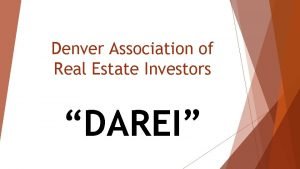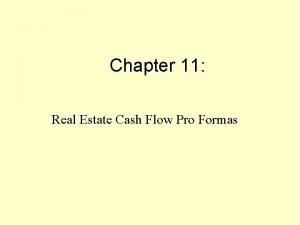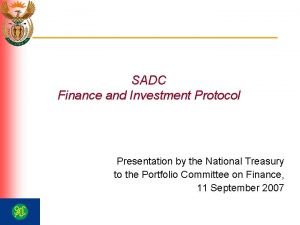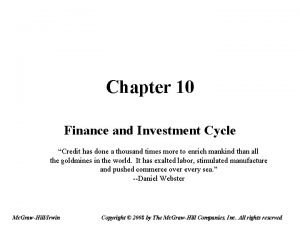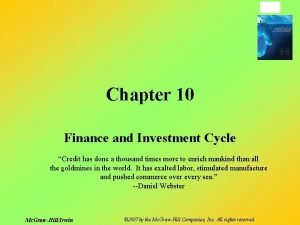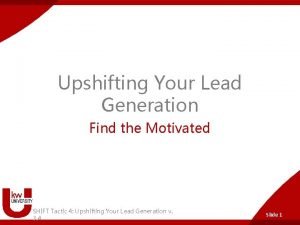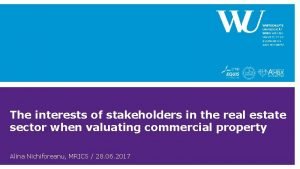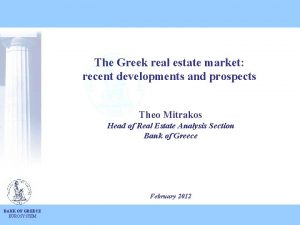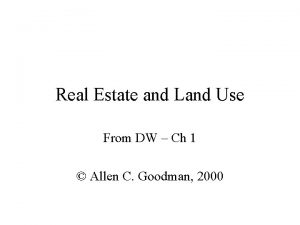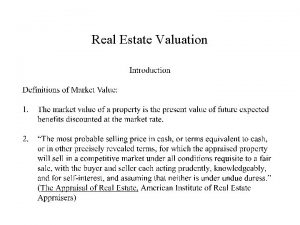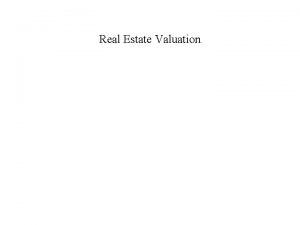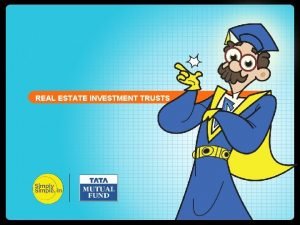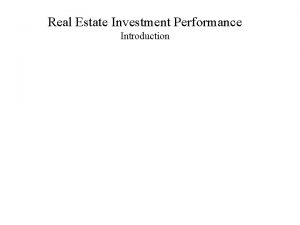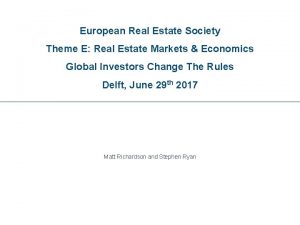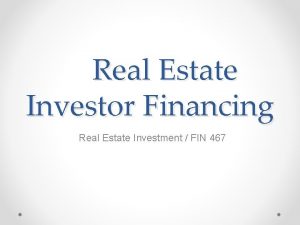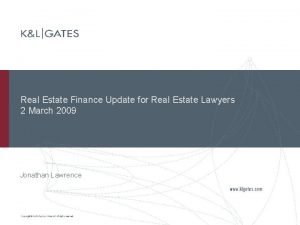Theme O Real Estate Finance Investment Session O3



















- Slides: 19

• Theme O: Real Estate Finance & Investment Session: O-3 Time: FRIDAY, 26. JUN. 2015 09: 00 -10: 30 Location: Taskisla Room 109 • Has anyone seen my neo-cortex? I’m sure I left it here somewhere. • Behavioural biases among real estate investment decision makers

In this session we will: § Identify some important behavioural biases § Consider these in the context of real estate investment markets § Suggest ways to reduce the possible impact of this behaviour Q&A to follow S Ryan and M Richardson ERES 2015 Has Anyone Seen My Neo-Cortex? 2

Thinking fast and slow A framework for understanding our biases Thinking Fast: System 1 Thinking Slow: System 2 Quick, automatic, intuitive and emotional. Slow, conscious, more deductive and logical. Default option for information processing. Examples: Quick Intuitive Practical Automatic Emotional Slow Rational Logical Deductive Structured Deliberate effort required means we often defer to System 1. Examples: Parking in a narrow space. Detecting hostility in someone’s voice. Multiplying several numbers. Judging which object is more distant Understanding the decisions we make

Knowing how our brains work might make us better investors Investors are prone to a range of systematic errors and psychological biases. These decision-making errors help to create inefficiencies in financial markets. They also help to explain irrational booms and busts like property crashes. Human psychology can have a big impact on investing. We make ‘cognitive’ errors on a routine basis by using rules of thumb and oversimplifications.

Examples of biases Self-deception Social Simplification § Confirmation bias § Framing and nudging § Herding § Hindsight bias § Representativeness § Priming § Narrative fallacy § Gambler’s fallacy § Imitation § Anchoring § Overconfidence § Cognitive dissonance § Information overload § Illusion of control/ illusion of knowledge § Loss aversion § Familiarity and mere exposure effect § Substitution § Halo effect § Hyperbolic discounting Let’s focus on FIVE key biases and how we can address them S Ryan and M Richardson ERES 2015 Has Anyone Seen My Neo-Cortex? 5

ANCHORING Clinging to an irrelevant piece of information such as a number SUBSTITUTION If a hard question cannot be answered quickly, an easier related one is found FRAMING Considering issues based on how they are formulated (framed) LOSS AVERSION Responding more strongly to losses than to gains HERDING Doing what everyone else seems to be doing S Ryan and M Richardson ERES 2015 Has Anyone Seen My Neo-Cortex? 6

• Local real estate agents were taken to a house and asked to appraise it • Each group of agents was given the same information packet about the house • Just one key difference - different groups were given different asking prices • Most participants stated that asking price should be irrelevant • Appraised values were positively related to the anchor, the asking price S Ryan and M Richardson ERES 2015 Has Anyone Seen My Neo-Cortex? 7

Example of a hard question q What is the true nature of this real estate investment? Easier related questions q Which familiar asset class does it resemble? q How did this property fund perform against its peers recently? Can lead to misunderstandings about nature of real estate It’s all about capital values Real estate is broadly the same everywhere You can buy the market, just like with equity Good asset allocation is all that matters

Framing: “data shape” determines our approach Why aggregate performance data by geography & sector? S Ryan and M Richardson ERES 2015 Has Anyone Seen My Neo-Cortex? 9

FRAMING 2. Framing Considering issues based on how they are formulated (framed) ü Market participants view decisions through the lens of industry norms ü Data made available shapes how we perceive risk and return ü Consistently use familiar but unhelpful frames of reference with which to position the asset class: 1. Focus on sectors 2. Focus on geographies “It’s kind of amazing what is not measured” – Robert Shiller ü Market participants view decisions through the lens of their own career risk and social standing 1. Focus on avoiding relative under-performance 2. Hugging the peer group (managers) or colleagues (investment committees) “…it is better for reputation to fail conventionally than to succeed unconventionally” – JM Keynes S Ryan and M Richardson ERES 2015 Has Anyone Seen My Neo-Cortex? 10

Chart shows magnitude and cyclical nature of the differential pricing strategy of “losers” and “gainers” during the property market cycle of 2001 -09 S Ryan and M Richardson ERES 2015 Has Anyone Seen My Neo-Cortex? 11

Loss aversion – US findings • • • Loss aversion exists in the commercial property market Of similar magnitude and impact as in the housing market Greater among larger institutions such as funds and REITs Behaviour carries through to: – Higher transaction prices (on average) – Longer time on the market The effect of loss aversion behavior varied over cycle – Increasing in the early stage of the peak and turning point – Collapsing as demand side weakness became apparent

LOSS AVERSION combined with HERDING Or why some investors sell at exactly the wrong time (using the UK commercial property crisis of 1988 -1993 for illustration) IPD UK Monthly All Property Capital Values Growth - Jan 1987 to June 1993 There is some evidence that investors use a rule of three to dealing with losses: Strike 1: They are prepared to ride out the first correction in the market. Strike 2: They are pained by the second correction but hold on. Strike 1 Strike 2 Strike 3 0 Strike 3: Finally, they capitulate after the third wave of selling pressure. The irony is that property markets often correct in three downward waves, meaning investors sell at the bottom. Precisely the wrong time. Sell Zone 0 Cheapest point to buy income return Source: FIL Limited, IPD UK Annual Digest 2014

HERDING Doing what everyone else seems to be doing Ireland – Investment Volume & No. Deal 2004 to 2014 Herding in real estate markets can push up the values of certain assets or sectors to extreme levels, causing bubbles. Largely on the basis of attractive capital returns (see Anchoring) Ireland – Initial yield by sector Dec 2004 to Dec 2014 Following the crowd can mean buying when prices are high and selling when prices are low, also known as ‘chasing the market’. This is a poor strategy but widely used in real estate See recent examples of “prime” assets and long lease strategies. . . Spain? Source: FIL Limited, IPD Ireland Quarterly Index March 2015

- We have looked at five cognitive biases that interfere with rational logic - Anchoring, framing, loss aversion and substitution fall into category of simplification - All four can be mitigated by moving to System 2 (Herding is different) S Ryan and M Richardson ERES 2015 Has Anyone Seen My Neo-Cortex? 15

Possible ways to mitigate the effects

Moving from System 1 to System 2 1. Run MVO exercises, treating income returns and capital returns as separate asset classes 2. When assessing risk-return ratios, use the coefficient of variation (risk per unit of return) 3. Estimate future cashflows, with particular emphasis on lease events 4. List in writing the pros and cons of each choice 5. Ignore sector and geographic data formulations (“frames”) S Ryan and M Richardson ERES 2015 Has Anyone Seen My Neo-Cortex? 17

The road towards better decisions ten tips for the real estate investor 1. I will forget the price I paid for an investment, to mitigate emotional anchors 2. I will analyse the income component of total return with particular attention 3. I will focus on expected returns, largely ignoring sector and geographic labels 4. I will not be seduced by top down asset allocation 5. I will strive to reduce my need for social validation, which encourages herding 6. I believe that most references to risk are really references to emotion 7. I believe that widening yields represent an opportunity rather than a risk 8. I will strive to eliminate my myopic loss aversion 9. I will resist the temptation to replace hard questions with easy ones

Sources Thinking, Fast and Slow by Daniel Kahneman Loss Aversion and Anchoring in Commercial Real Estate Pricing by Bokhari and Geltner Driving Emotions from your Investment Process by Tom Howard S Ryan and M Richardson ERES 2015 Has Anyone Seen My Neo-Cortex? 19
 Denver real estate investment associations
Denver real estate investment associations Cash flow pro
Cash flow pro Real estate finance fundamentals
Real estate finance fundamentals Rabo real estate finance
Rabo real estate finance 11245 lantern road fishers in 46038
11245 lantern road fishers in 46038 Fixed investment and inventory investment
Fixed investment and inventory investment Sadc protocol on finance and investment
Sadc protocol on finance and investment Finance and investment cycle
Finance and investment cycle Corporate finance vs investment banking
Corporate finance vs investment banking Finance and investment cycle
Finance and investment cycle 60 second elevator pitch
60 second elevator pitch What is a mofir
What is a mofir Real estate stakeholders
Real estate stakeholders Greece property market
Greece property market Sandy miller real estate
Sandy miller real estate Riparian and littoral rights
Riparian and littoral rights What are the 4 types of real estate
What are the 4 types of real estate Fundamentals of analyzing real estate investments
Fundamentals of analyzing real estate investments Strategicerp-real estate erp software
Strategicerp-real estate erp software Four quadrant model real estate
Four quadrant model real estate
